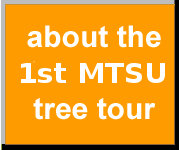
|

|

|

|
An individual instance of Platanus occidentalis (American sycamore)
Permanent unique identifier for this particular organism:
http://bioimages.vanderbilt.edu/mtsu/14
Notes:
Description
General: Planetree family (Platanaceae). Monoecious, native, deciduous trees with an open crown, among the largest of Eastern deciduous forests, reaching heights of 18-37 meters, and the greatest diameter of any temperate hardwood tree -- the largest known range 3-4 meters d.b.h.; twigs zig-zag, with only lateral buds; bark of upper trunk exfoliating in patches, leaving areas of inner bark exposed, a patchwork of browns, yellows, and greens against a background of white, the darker bark with age falling away in thin brittle sheets, exposing younger and lighter-colored bark. Leaves are deciduous, alternate, 10-35 cm long, palmate-veined and roughly star-shaped, with 3-5 sharp lobes. Fruit consists of numerous achenes in a pendulous, ball-shaped fruiting head 2-5 cm in diameter, the individual achenes drifting in the wind if the head breaks up on the tree.
Uses
Industry: American sycamore is grown in short-rotation plantations primarily for pulp and it also is used for rough lumber. The heavy, close-grained wood is difficult to split and work because of interlocking fibers. It has been used for butcher's blocks, furniture, veneer and interior trim, boxes and crates, flooring, and particle and fiberboard.
Conservation: American sycamore is a good planting where a large, fast-growing tree is desired. The huge size quickly attained by these trees is often underestimated.
Ethnobotanic: Native Americans used sycamore for a variety of medicinal purposes, including cold and cough remedies, as well as dietary, dermatological, gynecological, respiratory, and gastrointestinal aids.
Distribution
American sycamore is widespread in the eastern United States, from Texas to Nebraska, Iowa, and Wisconsin and into southern Ontario, Canada; it also occurs in the mountains of northeastern Mexico.
Adaptation
It often is a pioneer on upland sites in the central part of its range, but it is primarily a species of bottomland and alluvial soils, also occurring on creek banks, mesic coves and lower slopes, on a wide range of soil types. It is a major pioneer species in the floodplains of large rivers and occurs on a variety of wet sites, including shallow swamps, sloughs, and wet river bottoms. Water dispersal often results in seed deposition on muddy flats highly conducive to germination because seed dispersal occurs when water is receding after spring floods. American sycamore is most commonly found in mixture with sweetgum, boxelder, silver and red maple, cottonwood, and willows.
Establishment
Open-grown American sycamores usually begin flowering in 6-7 years. Natural stands of sycamore usually produce appreciable numbers of seed at approximately 25 years; optimum seed production occurs from 50-200 years of age.
References
USDA NRCS (2002). American sycamore plant guide. Retrieved from http://plants.usda.gov/java/factSheet

|

|
|
Load database and switch to thumbnail view
Use this stable URL to link to this page:
http://bioimages.vanderbilt.edu/mtsu/14.htm
This particular organism is believed to have managed means of establishment.
This organismal entity has the scope: multicellular organism.
Identifications:
Platanus occidentalis
L.
sec. Tennessee Flora 2014
common name: American sycamore
family: Platanaceae
Identified 2016-03-23 by Patrick Phoebus
Location:
Alumni Drive, Rutherford County, Tennessee, US
Click on these geocoordinates to load a map showing the location: 35.8451°, -86.3645°
Coordinate uncertainty about: 10 m.
Altitude: 190 m.
Location calculated as average of its images' coordinates.
Occurrences were recorded for this particular organism on the following dates:
2016-03-13
2016-04-27
The following images document this particular organism.
Click on a thumbnail to view the image and its metadata. Load database and enable navigation by taxon and organism.
| Image | View |
|
|
whole tree (or vine) - general |
|
|
whole tree (or vine) - winter |
|
|
whole tree (or vine) - winter |
|
|
bark - unspecified |
|
|
bark - of a large tree |
|
|
leaf - whole upper surface |